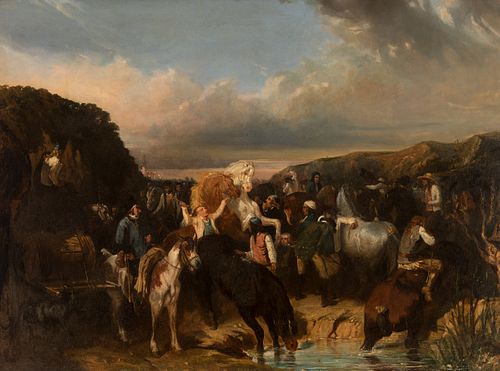JEAN-ANTOINE DUCLAUX (Lyon, France, 1783 - 1868). "Rest on the Road". Oil on canvas. Stamp on the back. Signed in the lower right corner. Measure
Lot 122
About Seller
Setdart Auction House
Carrer Aragó 346
Barcelona
Spain
Setdart Subastas was born in 2004 and is currently the first online art auction in Spain with solidity, prestige and reliability guaranteed by our more than 60,000 users. Setdart has a young, dynamic and enterprising team ready to successfully manage the purchase and sale of art works through custom...Read more
Estimate:
EUR€10,000 - EUR€12,000
$10,752.69 - $12,903.23
Absentee vs Live bid
Two ways to bid:
- Leave a max absentee bid and the platform will bid on your behalf up to your maximum bid during the live auction.
- Bid live during the auction and your bids will be submitted real-time to the auctioneer.
Bid Increments
| Price | Bid Increment |
|---|---|
| EUR€0 | EUR€10 |
| EUR€200 | EUR€25 |
| EUR€500 | EUR€50 |
| EUR€1,000 | EUR€100 |
| EUR€3,000 | EUR€200 |
| EUR€5,000 | EUR€500 |
| EUR€10,000 | EUR€1,000 |
| EUR€20,000 | EUR€2,000 |
| EUR€50,000 | EUR€5,000 |
About Auction
By Setdart Auction House
Oct 20, 2021
Set Reminder
2021-10-20 07:30:00
2021-10-20 07:30:00
America/New_York
Bidsquare
Bidsquare : OLD MASTERS
https://www.bidsquare.com/auctions/setdart-auction-house/old-masters-7700
Setdart Auction House sofia@setdart.com
Setdart Auction House sofia@setdart.com
- Lot Description
JEAN-ANTOINE DUCLAUX (Lyon, France, 1783 - 1868). "Rest on the Road". Oil on canvas. Stamp on the back. Signed in the lower right corner. Measurements: 98 x 130 cm; 121 x 157cm (frame). In this work, of romantic heritage, it is represented a multitude of characters and horses, stopped in their way next to a pond. The composition is determined by the V-shaped line formed by the nearby mountains, at the intersection of which, in the background, we see the outline of a city. Figures and animals are clearly individualised in their gestures and expressions, showing a narrative and costumbrista mood. On the other hand, the loose, impastoed brushstrokes give the scene vibrancy and naturalism. This style is directly linked to the great masters of the Golden Age, both European (Rembrandt, Rubens, Van Dyck, etc.) and Spanish (Velázquez, Ribera). A painter of landscapes and animals, Jean-Antoine Duclaux began his training by studying drawing in Lyon under Grognard. At the same time, he began working as a commercial clerk, which led him to travel to Naples in 1805 or 1806. There he became secretary to General Compère, and made numerous drawings of the Neapolitan landscape. From Italy he sent these works to Lyon, where he began to be known in artistic circles. When he returned to his native city, he continued to paint from sketches made in the open air, and his language matured thanks to the advice of Revoil and Fleury-Richard. He made his debut at the Paris Salon in 1812, and at the same official exhibition he was awarded a first-class medal only five years later, in 1817. During these years his main subject matter was the landscapes surrounding his house in Vourles, a village near Lyon. Around this time he also began to work in the technique of engraving, using mainly etching and dealing with the same landscape subjects as his easel work. In recent years his figure and his work have been recognised thanks to the outstanding exhibition devoted to him in 2013 by the Maison Forte de Vourles. Jean-Antoine Duclaux is currently represented in the Musée des Beaux-Arts in Lyon, the Musée des Ursulines in Mâcon, the Musée Fabre in Montpellier, the Musée de Brou in Bourg-en-Bresse and other collections, both public and private.
- Shipping Info
-
In-house shipping available. Please inquire at admin@setdart.com.
-
- Buyer's Premium



 EUR
EUR CAD
CAD AUD
AUD GBP
GBP MXN
MXN HKD
HKD CNY
CNY MYR
MYR SEK
SEK SGD
SGD CHF
CHF THB
THB









